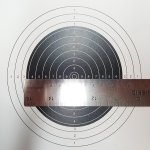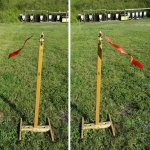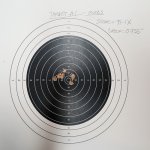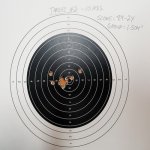Got myself started with target sight aperture shooting, benchrest with rifle supported with front rest and rear bag. I plan to try unsupported positional shooting soon, once I get some experience on the bench with the apertures.
My only experience target shooting is with high magnification scopes, so this is very new to me. I am already hooked and cannot get enough of it. I am over 60 so unsure if the body and eyes will last, but here goes....
I have several topics to talk about, so I will break them out in separate posts.
First topic is the gear:
Already had the Anschutz 1907 with the dovetail rails on receiver and barrel behind the muzzle, so its made for aperture sights.
Nordic Marksman had the sights I needed. I bought the Anschutz 6834 sight set M18, (entry level, but good entry level), and a set of plastic aperture inserts for the front sight.
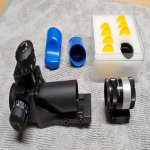
Those front sight caps are handy. I am discovering that the plastic inserts get covered in finger prints and dust very easily, and the caps provide some protection for the front sight in transport. I also bought a padded carrying case for the sights.
The byline for the Rimfire forum is "Fun stuff that won't break your piggy bank...". I think rimfire is putting some stress on my piggy bank!
Took me a while to understand what the Germans mean by up and down elevation dialing. Up and down are the opposite of what it means to me for an optical scope.
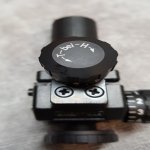
Up "H" (for "Hoch" translates to English "Up") will dial the rear aperture housing down and makes POI go down. Down ("T" for "Tief" (I think) translates to English "Deep"), will dial the aperture housing up and make POI go up. I don't get what Anschutz means by up and down (deep) dialing arrow direction, but anyways I figured it out and its all good. The dials are very crisp and clicky.
The rifle with aperture sights mounted:
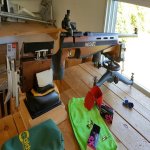
I now know I need a backwards rail extender for the rear sight. At the bench I am craning my neck to get to the rear aperture and its not comfortable, but the extension rail should fix that.
My spotting scope was set up on a full size tripod behind the bench off the left side of this frame. I do not yet have a secure bench-top tripod for the spotting scope.
Next post topic: Front aperture size and 50m/yard target sizes:
My only experience target shooting is with high magnification scopes, so this is very new to me. I am already hooked and cannot get enough of it. I am over 60 so unsure if the body and eyes will last, but here goes....
I have several topics to talk about, so I will break them out in separate posts.
First topic is the gear:
Already had the Anschutz 1907 with the dovetail rails on receiver and barrel behind the muzzle, so its made for aperture sights.
Nordic Marksman had the sights I needed. I bought the Anschutz 6834 sight set M18, (entry level, but good entry level), and a set of plastic aperture inserts for the front sight.

Those front sight caps are handy. I am discovering that the plastic inserts get covered in finger prints and dust very easily, and the caps provide some protection for the front sight in transport. I also bought a padded carrying case for the sights.
The byline for the Rimfire forum is "Fun stuff that won't break your piggy bank...". I think rimfire is putting some stress on my piggy bank!
Took me a while to understand what the Germans mean by up and down elevation dialing. Up and down are the opposite of what it means to me for an optical scope.

Up "H" (for "Hoch" translates to English "Up") will dial the rear aperture housing down and makes POI go down. Down ("T" for "Tief" (I think) translates to English "Deep"), will dial the aperture housing up and make POI go up. I don't get what Anschutz means by up and down (deep) dialing arrow direction, but anyways I figured it out and its all good. The dials are very crisp and clicky.
The rifle with aperture sights mounted:

I now know I need a backwards rail extender for the rear sight. At the bench I am craning my neck to get to the rear aperture and its not comfortable, but the extension rail should fix that.
My spotting scope was set up on a full size tripod behind the bench off the left side of this frame. I do not yet have a secure bench-top tripod for the spotting scope.
Next post topic: Front aperture size and 50m/yard target sizes:


















































